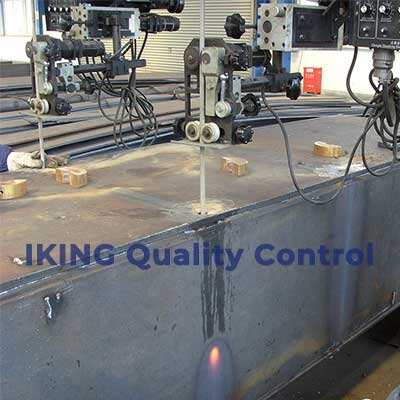1. Metallurgical Principles of Electroslag Welding
The metallurgical behavior of electroslag welding (ESW) fundamentally determines weld quality, directly influencing chemical composition, microstructure, and mechanical properties.
1.1 Slag-Metal Interaction
The conductive slag pool (e.g., CaF2-Al2O3-based flux) generates stable temperatures of 1,700-2,000℃, serving dual roles:
Purification: Slag absorbs oxides (e.g., SiO2, MnO) and sulfides (e.g., FeS), reducing impurities.
Alloy Adjustment: Components like CaO and TiO2 regulate silicon/manganese content, enhancing toughness.
Case Study: HJ360 flux, with 8-12% MnO, increases Charpy impact toughness of low-carbon steel welds to≥80J at room temperature.
1.2 Element Transfer and Distribution
Electrodes (wires or plates) supply alloying elements. Due to prolonged molten pool residence (up to minutes), transition efficiency for elements like Ni/Cr exceeds 95%. Key considerations:
Carbon Loss: Compensated by adding carbon to wires (e.g., H08Mn2SiA with 0.10-0.15% C).
Hydrogen Management: Fluorides (CaF2) in slag bind hydrogen into HF gas, minimizing cracking risks.
1.3 Microstructural Evolution
Columnar Crystals: Coarse vertical grain growth necessitates post-weld normalizing.
Heat-Affected Zone (HAZ): A 10-20mm-wide bainite-dominated zone requires controlled cooling to prevent embrittlement.
2. Critical Factors for Weld Quality Control
Quality assurance relies on parameter optimization, material compatibility, and equipment reliability.
2.1 Parameter Optimization
Current (400-1,000A): Governs deposition rate; excessive values induce turbulence and porosity.
Voltage (35-55V): Affects weld width; a 5V increase expands width by 2-3mm.
Travel Speed (0.5-1.5m/h): Slow speeds cause overheating; high speeds risk incomplete fusion.
Optimization Example: For 300mm-thick steel in the Three Gorges Project, 800A/45V/0.8m/h balanced penetration and width.
2.2 Flux and Electrode Compatibility
Flux Selection:
HJ170: High conductivity but poor detachability, ideal for slag initiation.
HJ431: Versatile for low-carbon/low-alloy steels with excellent slag removal.
Electrode Materials:
H10Mn2 Wire: 1.5-1.8% Mn for Q345 steel welds.
Q295 Nozzle Plates: Matches base metal composition to minimize interfacial stress.
2.3 Equipment and Operational Standards
Water-Cooled Shoe Maintenance: Ensure coolant flow≥10L/min to prevent leakage.
Flux Recycling: Achieve>95% reuse to avoid impurity accumulation.

3. Defect Analysis and Mitigation Strategies
3.1 Porosity and Slag Inclusion
Causes: Incomplete slag coverage or moisture-contaminated flux (>0.1% H2O).
Solutions:
Pre-dry flux (300℃×2h).
Increase slag pool depth to 40-60mm for gas escape.
3.2 Cracking (Hot/Cold)
Hot Cracks: Caused by low-melting eutectics (e.g., FeS); suppress via Mn/S ratio >40.
Cold Cracks: Hydrogen-induced; control flux moisture (<0.05%) and apply slow cooling.
3.3 Lack of Fusion and Undercut
Lack of Fusion: Insufficient current or narrow gaps (<28mm); adjust parameters or widen gaps.
Undercut: Poor fluidity; employ wire oscillation (2-3Hz).
4. Industrial Quality Control Practices
4.1 Wind Turbine Tower Fabrication
Challenge: 60-150mm plates meeting EN 1011-2 standards.
Solution:
Twin-wire ESW (IK-ESW5000) boosts deposition efficiency by 50%.
Post-weld normalizing (920℃×2h) refines HAZ grains to ASTM 5-6.
4.2 Nuclear Reactor Pressure Vessels
Standard: ASME Section III mandates >99.5% UT pass rate.
Measures:
Ultra-pure flux (S/P <0.015%).
Real-time slag pool monitoring (±10℃ accuracy) to prevent segregation.
5. Emerging Trends
Smart Monitoring: IoT sensors for real-time chemical and thermal analysis.
Eco-Friendly Fluxes: Low-fluoride formulations (F <5%) to reduce environmental impact.
Conclusion
Mastering the metallurgical principles and quality control strategies of ESW enables consistent, high-performance welds across industries. Through precise parameter tuning, material synergy, and advanced equipment, this process bridges laboratory precision with industrial-scale reliability.
 Hot News
Hot News